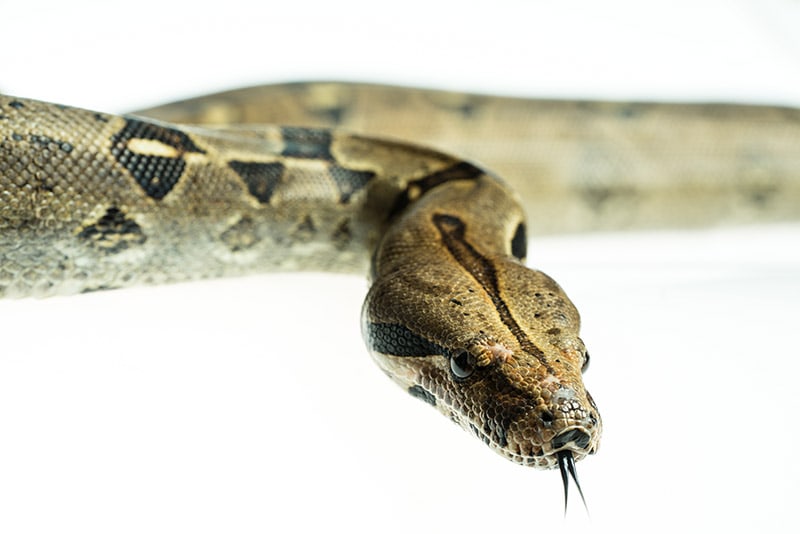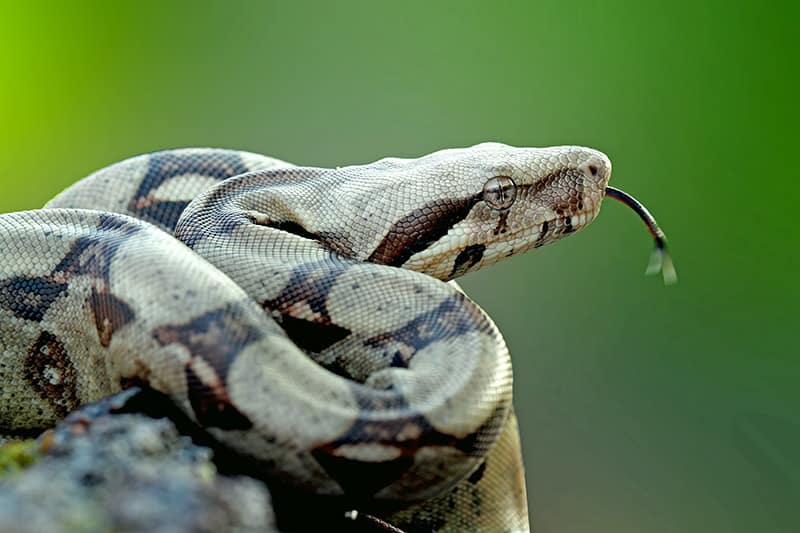The Colombian Boa or Common Boa has an exotic appearance, and is considered by many to be the most beautiful of the constrictors.
This attractive snake is desirable because it is readily tamed and easy to maintain. The captive born and raised Colombian Boas are usually very docile. They can easily be kept by a beginner as well as the experienced herptile keeper. Very young snakes are delicate and subject to illness so look for small adults.
| Dr. Jungle says… “What’s in a name? Lets hear from the expert….! | |
|---|---|
 Boa constrictor imperator Photo © Animal-World: David Brough | “The Boas that we see imported by the thousands from Colombia are not True Red Tailed Boas as they are Boa c. imperator which is found West of the Andes Mountains. “These Colombian boas are considered to be non red tailed (although they do possess a red tail). They are instead referred to as “Common Boas ” or Colombian Boas. “True ‘Red Tailed’ Boas are the nominant race, Boa c. constrictor. The True Red Tailed Boas are the boas found East of the Andes Mountains in South America (Surinam, Guyana, Brazil, Peru, etc. ). They get much larger than Colombian Boas and have very deep red tails.” …Vin Russo Vin Russo is one of the top breeders and most well-respected boa experts in the United States Cutting Edge Herpetological Inc. |
- For more information on keeping Snakes see: Guide to a Happy, Healthy Herptile
Colombian Boa Constrictor
Scientific Classification
| Kingdom: | Animalia |
| Phylum: | Chordata |
| Class: | Reptilia |
| Order: | Squamata |
| Family: | Boidae |
| Genus: | Boa |
| Species: | constrictor |
Distribution
The Colombian Boa or Common Boa is found throughout a large range of South America. They are found in Colombia of course, but also in Guyana, Peru, Suriname, Hogg Island, Venezuela, and more.
Description
The Colombian Boa constrictor will grow to between six and nine feet, though they can reach up to 12 feet. The males are smaller than the females. This snake is robust, with a triangular head separated from the body by a thin neck.
Their natural coloring is a pattern of elongated, saddle like, pale gray patches on a background of rich chocolate to almost chestnut brown. The sides are paler with dark brown, diamond shaped spots that have white centers. The undersides are yellowish, spotted with black. The chestnut brown coloring becomes progressively brighter until it is a brick red or pure red, and they are thus sometimes called the ‘Colombian Red Tailed Boa’. This name is a bit misleading as the True Red Tail Boa Boa c. constrictor, is the nominant race. (See the box above.)

Feeding
They are a constrictor and their diet consists of mice, rats, small rabbits and the large snakes can also eat chickens. Feed once or twice a week, depending on the size of the food and the size of the snake. As you get to know your snake, you’ll learn what its feeding needs are. Fresh water in a good size water dish should always be available.
Environment
These snakes are best kept singly except when they are being bred, but you may be able to keep them with other snakes the same size as long as you feed them separately.
The Colombian Boa constrictor needs a good-sized cage. Its’ housing can be set up as a woodland-type terrarium, but keep the decor to the minimum. See the terrarium set-ups described under Basic Reptile and Amphibian Care for more information. A good-sized water dish will provide moderate humidity as well as a place for soaking and drinking. A heavy limb for climbing on, resting on, and to aid in shedding makes the perfect decor.
Temperature and Lighting requirements
They do well at 82° to 95° F in the daytime and 72° to 80° F at night. Full spectrum lighting is important for your snakes well being and its long-term maintenance. You can use a substrate heating device for basic heating. For additional heat, you can add a full spectrum incandescent daytime bulb and a blacklight bulb or red incandescent bulb for nighttime heating. Be sure you use a thermometer so you don’t let the terrarium become overheated!
- For more detailed information see the Basic Reptile and Amphibian Care: Housing.

Breeding/Reproduction
These snakes, if not babies, need to be probe sexed for positive sex identification, and they bear live young. Their gestation period can range from four to six months. The litters are large with up to 30 babies, each about 24 inches (61 cm) long and resembling the coloring and patterning of their parents. They are fairly easy to breed in captivity.
Availability
The Colombian Boa constrictors or Common boas are very common and readily available due to captive breeding.
Featured Image Credit: Opayaza12, Shutterstock
